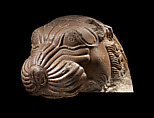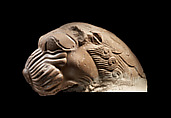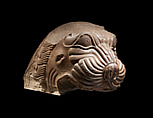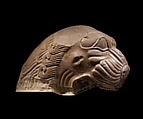Returned to lender The Met accepts temporary loans of art both for short-term exhibitions and for long-term display in its galleries.
Fragment of a lion capital
India, Masarh, Shahabad district, Bihar
Not on view
This fragment of a lion, part of a double-ended capital, was recovered at the ancient Mauryan capital of Masarh, in western Bihar. Its power and ferocity echo heraldic beasts of the earlier Achaemenid Empire (550–330 BCE; present-day Iran) to the west. That the Mauryan king Chandragupta had a densely pillared audience hall similar to those of the Persians, and that both dynasties favored highly polished and reflective stone finishes, points to their close cultural interaction. The lion had long served as an emblem of royal strength and nobility. In the mid-third century BCE, the roaring lion became a metaphor for the Buddha, the lion of the Shakya clan.
Due to rights restrictions, this image cannot be enlarged, viewed at full screen, or downloaded.
This artwork is meant to be viewed from right to left. Scroll left to view more.





